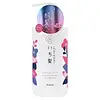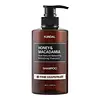What's inside
What's inside
 Key Ingredients
Key Ingredients

No key ingredients
 Benefits
Benefits

 Concerns
Concerns

 Ingredients Side-by-side
Ingredients Side-by-side

Water
Skin ConditioningLauroyl Sarcosine
CleansingPalm Kernelamidopropyl Betaine
CleansingCocamide Methyl Mea
Lauroyl Methyl Beta-Alanine
Skin ConditioningCocamide Mea
EmulsifyingGlycol Distearate
EmollientAngelica Keiskei Leaf/Stem Extract
Skin ConditioningOryza Sativa Bran Oil
EmollientOryza Sativa Extract
AbsorbentDianthus Longicalyx Seed Extract
Emulsion StabilisingRubus Idaeus Extract
Skin ProtectingZea Mays Germ Oil
EmollientRubus Fruticosus Fruit Extract
AstringentCamellia Sinensis Seed Extract
HumectantOryza Sativa Bran Extract
Skin ConditioningCitric Acid
BufferingPEG-7 Glyceryl Cocoate
EmulsifyingSodium Chloride
MaskingGuar Hydroxypropyltrimonium Chloride
Skin ConditioningPolyquaternium-7
Polyquaternium-10
Butylene Glycol
HumectantAlcohol Denat.
AntimicrobialPropanediol
SolventDisodium EDTA
Sodium Benzoate
MaskingParfum
MaskingCaramel
Cosmetic ColorantWater, Lauroyl Sarcosine, Palm Kernelamidopropyl Betaine, Cocamide Methyl Mea, Lauroyl Methyl Beta-Alanine, Cocamide Mea, Glycol Distearate, Angelica Keiskei Leaf/Stem Extract, Oryza Sativa Bran Oil, Oryza Sativa Extract, Dianthus Longicalyx Seed Extract, Rubus Idaeus Extract, Zea Mays Germ Oil, Rubus Fruticosus Fruit Extract, Camellia Sinensis Seed Extract, Oryza Sativa Bran Extract, Citric Acid, PEG-7 Glyceryl Cocoate, Sodium Chloride, Guar Hydroxypropyltrimonium Chloride, Polyquaternium-7, Polyquaternium-10, Butylene Glycol, Alcohol Denat., Propanediol, Disodium EDTA, Sodium Benzoate, Parfum, Caramel
Water
Skin ConditioningSodium Cocoyl Alaninate
Lauryl Hydroxysultaine
CleansingLauryl Glucoside
CleansingSodium Cocoyl Isethionate
CleansingErythritol
HumectantGlycerin
HumectantSodium Methyl Cocoyl Taurate
CleansingHoney Extract
HumectantMacadamia Ternifolia Seed Extract
EmollientSesamum Indicum Seed Extract
Skin ConditioningOenothera Biennis Flower Extract
AstringentGlycine Soja Seed Extract
Skin ConditioningVaccinium Angustifolium Fruit Extract
Skin ProtectingUndaria Pinnatifida Extract
Skin ConditioningFragaria Chiloensis Fruit Extract
Skin ConditioningMorus Alba Root Extract
BleachingCornus Officinalis Fruit Extract
Skin ConditioningTaraxacum Officinale Leaf Extract
Skin ConditioningRubus Fruticosus Fruit Extract
AstringentOryza Sativa Extract
AbsorbentNelumbo Nucifera Flower Extract
Skin ConditioningAngelica Gigas Root Extract
Skin ConditioningRosa Centifolia Flower Extract
AstringentHibiscus Sabdariffa Flower Extract
Skin ConditioningCamellia Sinensis Leaf Extract
AntimicrobialUlmus Davidiana Root Extract
Skin ConditioningLavandula Angustifolia Flower Extract
CleansingMelissa Officinalis Leaf Extract
Skin ConditioningChamomilla Recutita Flower Extract
MaskingCentella Asiatica Extract
CleansingPelargonium Graveolens Extract
MaskingOriganum Vulgare Leaf Extract
Skin ConditioningEucalyptus Globulus Leaf Extract
PerfumingPanax Ginseng Root Extract
EmollientRehmannia Chinensis Root Extract
Skin ConditioningPueraria Lobata Root Extract
HumectantThymus Vulgaris Extract
PerfumingMelaleuca Alternifolia Leaf Extract
PerfumingMentha Piperita Leaf Extract
Skin ConditioningGlycyrrhiza Uralensis Root Extract
Skin ConditioningRosmarinus Officinalis Leaf Extract
AntimicrobialScutellaria Baicalensis Root Extract
AstringentSaccharomyces Cerevisiae Extract
Skin ConditioningLaminaria Japonica Extract
Skin ProtectingSalicornia Herbacea Extract
Skin ConditioningBrassica Napus Extract
Skin ConditioningNarcissus Pseudo-Narcissus Flower Extract
Skin ConditioningPinus Palustris Leaf Extract
TonicPolygonum Cuspidatum Root Extract
AntioxidantDiospyros Kaki Fruit Extract
Skin ConditioningCamellia Japonica Leaf Extract
Skin ConditioningCeratonia Siliqua Fruit Extract
MaskingArgania Spinosa Kernel Oil
EmollientSimmondsia Chinensis Seed Oil
EmollientCocos Nucifera Oil
MaskingPersea Gratissima Oil
Skin ConditioningMacadamia Ternifolia Seed Oil
EmollientButyrospermum Parkii Butter
Skin ConditioningGuar Hydroxypropyltrimonium Chloride
Skin ConditioningPolyquaternium-10
Sodium Chloride
MaskingBetaine
HumectantAllantoin
Skin ConditioningPanthenol
Skin ConditioningArginine
MaskingSodium Gluconate
Skin ConditioningCitric Acid
BufferingCoconut Acid
CleansingSodium Isethionate
CleansingButylene Glycol
HumectantDipropylene Glycol
HumectantDipotassium Glycyrrhizate
Humectant1,2-Hexanediol
Skin ConditioningEthylhexylglycerin
Skin ConditioningHydroxyacetophenone
AntioxidantCaprylyl Glycol
EmollientParfum
MaskingWater, Sodium Cocoyl Alaninate, Lauryl Hydroxysultaine, Lauryl Glucoside, Sodium Cocoyl Isethionate, Erythritol, Glycerin, Sodium Methyl Cocoyl Taurate, Honey Extract, Macadamia Ternifolia Seed Extract, Sesamum Indicum Seed Extract, Oenothera Biennis Flower Extract, Glycine Soja Seed Extract, Vaccinium Angustifolium Fruit Extract, Undaria Pinnatifida Extract, Fragaria Chiloensis Fruit Extract, Morus Alba Root Extract, Cornus Officinalis Fruit Extract, Taraxacum Officinale Leaf Extract, Rubus Fruticosus Fruit Extract, Oryza Sativa Extract, Nelumbo Nucifera Flower Extract, Angelica Gigas Root Extract, Rosa Centifolia Flower Extract, Hibiscus Sabdariffa Flower Extract, Camellia Sinensis Leaf Extract, Ulmus Davidiana Root Extract, Lavandula Angustifolia Flower Extract, Melissa Officinalis Leaf Extract, Chamomilla Recutita Flower Extract, Centella Asiatica Extract, Pelargonium Graveolens Extract, Origanum Vulgare Leaf Extract, Eucalyptus Globulus Leaf Extract, Panax Ginseng Root Extract, Rehmannia Chinensis Root Extract, Pueraria Lobata Root Extract, Thymus Vulgaris Extract, Melaleuca Alternifolia Leaf Extract, Mentha Piperita Leaf Extract, Glycyrrhiza Uralensis Root Extract, Rosmarinus Officinalis Leaf Extract, Scutellaria Baicalensis Root Extract, Saccharomyces Cerevisiae Extract, Laminaria Japonica Extract, Salicornia Herbacea Extract, Brassica Napus Extract, Narcissus Pseudo-Narcissus Flower Extract, Pinus Palustris Leaf Extract, Polygonum Cuspidatum Root Extract, Diospyros Kaki Fruit Extract, Camellia Japonica Leaf Extract, Ceratonia Siliqua Fruit Extract, Argania Spinosa Kernel Oil, Simmondsia Chinensis Seed Oil, Cocos Nucifera Oil, Persea Gratissima Oil, Macadamia Ternifolia Seed Oil, Butyrospermum Parkii Butter, Guar Hydroxypropyltrimonium Chloride, Polyquaternium-10, Sodium Chloride, Betaine, Allantoin, Panthenol, Arginine, Sodium Gluconate, Citric Acid, Coconut Acid, Sodium Isethionate, Butylene Glycol, Dipropylene Glycol, Dipotassium Glycyrrhizate, 1,2-Hexanediol, Ethylhexylglycerin, Hydroxyacetophenone, Caprylyl Glycol, Parfum
 Reviews
Reviews

Ingredients Explained
These ingredients are found in both products.
Ingredients higher up in an ingredient list are typically present in a larger amount.
Butylene Glycol (or BG) is used within cosmetic products for a few different reasons:
Overall, Butylene Glycol is a safe and well-rounded ingredient that works well with other ingredients.
Though this ingredient works well with most skin types, some people with sensitive skin may experience a reaction such as allergic rashes, closed comedones, or itchiness.
Learn more about Butylene GlycolCitric Acid is an alpha hydroxy acid (AHA) naturally found in citrus fruits like oranges, lemons, and limes.
Like other AHAs, citric acid can exfoliate skin by breaking down the bonds that hold dead skin cells together. This helps reveal smoother and brighter skin underneath.
However, this exfoliating effect only happens at high concentrations (20%) which can be hard to find in cosmetic products.
Due to this, citric acid is usually included in small amounts as a pH adjuster. This helps keep products slightly more acidic and compatible with skin's natural pH.
In skincare formulas, citric acid can:
While it can provide some skin benefits, research shows lactic acid and glycolic acid are generally more effective and less irritating exfoliants.
Most citric acid used in skincare today is made by fermenting sugars (usually from molasses). This synthetic version is identical to the natural citrus form but easier to stabilize and use in formulations.
Read more about some other popular AHA's here:
Learn more about Citric AcidThis ingredient is derived from guar gum.
It is a conditioning ingredient, meaning it helps soften skin and hair.
Oryza Sativa Extract comes from the rice grain, Oryza sativa. Rice extract has wound healing, antioxidant, anti-inflammatory, and hydrating properties.
Rice grains contain numerous antioxidants which may help with anti-aging, such as vitamin E. Antioxidants help stabilize free-radical molecules. Unstable free-radical molecules may damage your skin cells and accelerate signs of aging.
A study from 2002 found rice to help increase the rate of wound healing. The same study found an improvement of skin barrier function in the patients after taking rice baths.
Numerous in-vitro studies have found rice water to help decrease sun damage by increasing collagen production and inhibiting the process of tyrosinase.
Long story short- tyrosinase is an enzyme that controls melanin production. Our bodies start producing melanin (AKA tanning) when exposed to UV radiation to protect against damage. Rice water is found to partially block this process.
Though more research is needed on rice's ability to help with UV protection, recent studies seem promising.
Wondering why rice is hydrating? The protein in rice have emollient properties. Emollients create a barrier on the skin to trap moisture in, keeping your skin moisturized.
Some rice extract may have mildly-exfoliating properties. These are mainly limited to Oryza Sativa (Rice) Bran and Oryza Sativa (Rice) Germ Powder.
This rice was first cultivated in China over 10,000 years ago. Many cultures throughout Asia have used rice water on skin and hair for centuries.
Learn more about Oryza Sativa ExtractParfum is a catch-all term for an ingredient or more that is used to give a scent to products.
Also called "fragrance", this ingredient can be a blend of hundreds of chemicals or plant oils. This means every product with "fragrance" or "parfum" in the ingredients list is a different mixture.
For instance, Habanolide is a proprietary trade name for a specific aroma chemical. When used as a fragrance ingredient in cosmetics, most aroma chemicals fall under the broad labeling category of “FRAGRANCE” or “PARFUM” according to EU and US regulations.
The term 'parfum' or 'fragrance' is not regulated in many countries. In many cases, it is up to the brand to define this term.
For instance, many brands choose to label themselves as "fragrance-free" because they are not using synthetic fragrances. However, their products may still contain ingredients such as essential oils that are considered a fragrance by INCI standards.
One example is Calendula flower extract. Calendula is an essential oil that still imparts a scent or 'fragrance'.
Depending on the blend, the ingredients in the mixture can cause allergies and sensitivities on the skin. Some ingredients that are known EU allergens include linalool and citronellol.
Parfum can also be used to mask or cover an unpleasant scent.
The bottom line is: not all fragrances/parfum/ingredients are created equally. If you are worried about fragrances, we recommend taking a closer look at an ingredient. And of course, we always recommend speaking with a professional.
Learn more about ParfumPolyquaternium-10 is an ammonium salt of hydroxyethylcellulose. It is a white and granular powder used as a film-former and anti-static agent.
This ingredient is commonly found in hair conditioning products. According to a manufacturer, its positive charge makes it great for absorbing hair proteins. The manufacturer also states this ingredient helps with curl retention.
For haircare friends: this ingredient is not a silicone.
Learn more about Polyquaternium-10Blackberry extract is rich in antioxidants and Vitamin C. The majority of antioxidants include flavonoid, phenolic, and anthocyanins.
Antioxidants help fight free-radicals. Free-radicals are molecules that may damage your skin cells, such as pollution. This may help reduce the symptoms related to aging.
Vitamin C contains many skin benefits.
Learn more about Rubus Fruticosus Fruit ExtractChances are, you eat sodium chloride every day. Sodium Chloride is also known as table salt.
This ingredient has many purposes in skincare: thickener, emulsifier, and exfoliator.
You'll most likely find this ingredient in cleansers where it is used to create a gel-like texture. As an emulsifier, it also prevents ingredients from separating.
There is much debate on whether this ingredient is comedogenic. The short answer - comedogenic ratings don't tell the whole story. Learn more about comegodenic ratings here.
The concensus about this ingredient causing acne seems to be divided. Research is needed to understand if this ingredient does cause acne.
Scrubs may use salt as the primary exfoliating ingredient.
Learn more about Sodium ChlorideWater. It's the most common cosmetic ingredient of all. You'll usually see it at the top of ingredient lists, meaning that it makes up the largest part of the product.
So why is it so popular? Water most often acts as a solvent - this means that it helps dissolve other ingredients into the formulation.
You'll also recognize water as that liquid we all need to stay alive. If you see this, drink a glass of water. Stay hydrated!
Learn more about Water